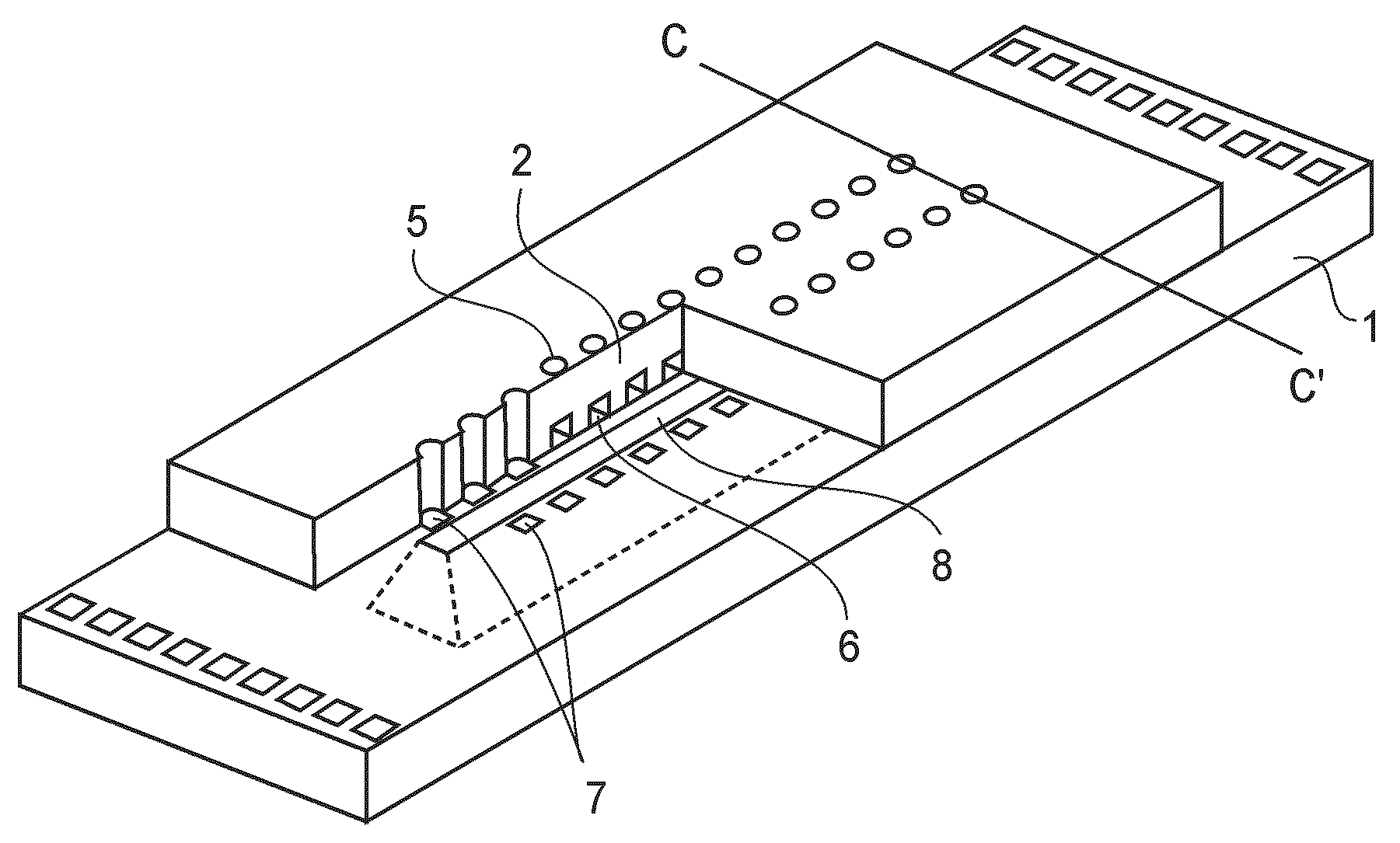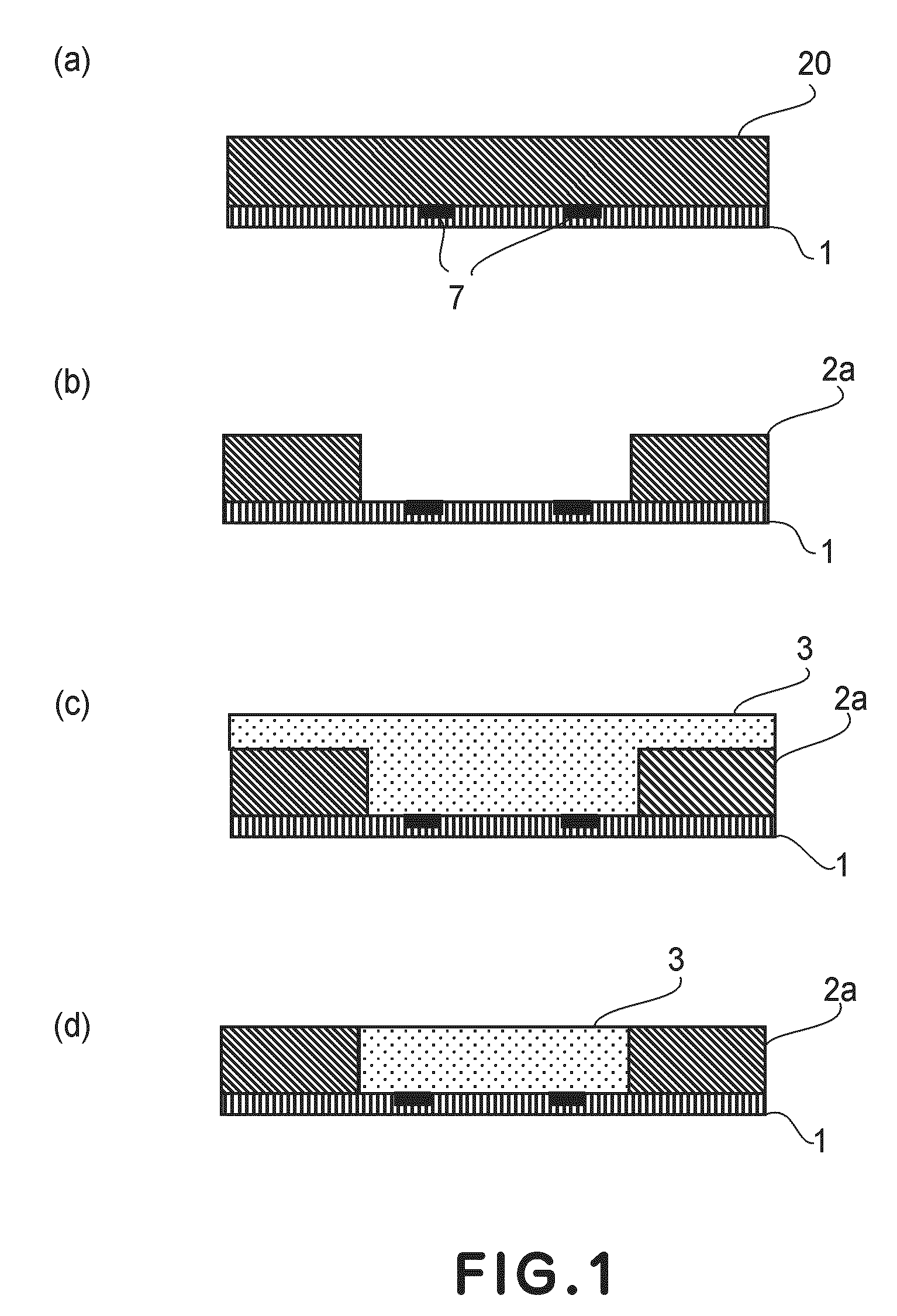Manufacturing method of liquid ejection head
- Summary
- Abstract
- Description
- Claims
- Application Information
AI Technical Summary
Benefits of technology
Problems solved by technology
Method used
Image
Examples
embodiment 1
[0070]First, on the substrate 1 provided with heat generating resistors 7 as an energy generating element, a negative photosensitive resin material consisting of Composition 1 shown below was spin-coated in a thickness of 10 μm, followed by pre-baking on a hot plate at 90° C. for 3 minutes to form a negative photosensitive resin layer 20 (FIG. 1(a)).
[0071]
Epoxy resin (“EHPE”, mfd. by DAICEL CHEMICAL100 wt. partsINDUSTRIES, LTD.)Additive (“1,4-HFAB”, mfd. by Central Glass Co., 20 wt. partsLtd.)Photo-cation polymerization initiator (“SP-170”, 2 wt. partsmfd. by ADEKA CORPORATION)Catalyst (“A-187”, mfd. by Nippon Unicar Co., 5 wt. partsLtd.)Solvent (methyl isobutyl ketone)100 wt. partsSolvent (diglyme)100 wt. parts
[0072]Next, the negative photosensitive resin layer 20 was exposed to light of a wavelength of 290-400 nm at an exposure amount of 500 mJ / cm2 by using an aligner (“MPA-600”, mfd. by Canon Kabushiki Kaisha) and then was subject to PEB (post exposure bake) at 90° C. for 4 minut...
embodiment 2
[0085]Until the step shown in FIG. 2(a), the manufacturing method of the recording head was performed in the same manner as in Embodiment 1.
[0086]Then, on the first layer 2b, the second layer 2c was formed of Composition 2 by spin coating, followed by pre-baking (FIG. 6(a)).
[0087]Next, the first layer 2b was exposed to the light of the wavelength of 290-400 nm, followed by baking to form a cured portion 4 as a part of a flow passage-forming member (FIG. 6(b)).
[0088]Next, the second layer 2c was exposed to the light of the wavelength of 365 nm, followed by baking to form a cured portion 12 as an ejection outlet-forming member (FIG. 2(d)).
[0089]Thereafter, the manufacturing method was carried out in the same manner as in Embodiment 1.
[0090]In this embodiment, the first layer 2b has a low photosensitivity to the light of the wavelength of 365 nm used for exposing the second layer 2c, so that an unexposed portion 10 of the first layer 2b is not photosensitive to the light. Therefore, it...
embodiment 3
[0091]A manufacturing method of a recording head will be described with reference to FIGS. 3(a) to 3(c) which are schematic sectional views similar to FIGS. 1(a) to 1(d).
[0092]Until the step shown in FIG. 2(a), the manufacturing method was performed in the same manner as in Embodiment 1.
[0093]Next, a negative photosensitive resin layer having low photosensitivity was formed as the first layer 2b in a thickness of 3 μm by spin coating and then a negative photosensitive resin layer having high photosensitivity was formed as the second layer 2c in a thickness of 10 μm by spin coating.
[0094]The first layer 2b was formed of the following photocurable composition.
EHPE-3150 (cation-polymerizable compound) (trade50wt. partsname, mfd. by DAICEL CHEMICAL INDUSTRIES,LTD.)SP-172 (photo-cation polymerization initiator)1wt. part(trade name, mfd. by ADEKA CORPORATION)A-187 (silane coupling agent) (trade name, mfd. by2.5wt. partsNippon Unicar Co., Ltd.)
[0095]To these ingredients, triethanol amine (...
PUM
 Login to View More
Login to View More Abstract
Description
Claims
Application Information
 Login to View More
Login to View More - R&D
- Intellectual Property
- Life Sciences
- Materials
- Tech Scout
- Unparalleled Data Quality
- Higher Quality Content
- 60% Fewer Hallucinations
Browse by: Latest US Patents, China's latest patents, Technical Efficacy Thesaurus, Application Domain, Technology Topic, Popular Technical Reports.
© 2025 PatSnap. All rights reserved.Legal|Privacy policy|Modern Slavery Act Transparency Statement|Sitemap|About US| Contact US: help@patsnap.com



